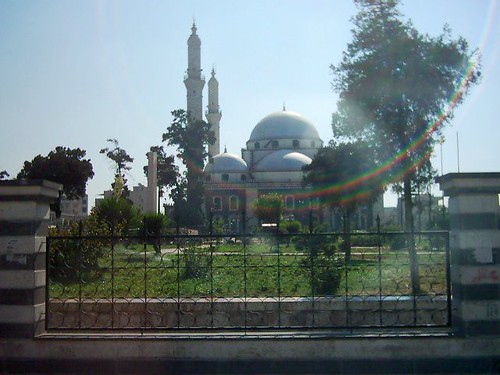Sword of God
one of the most important historical buildings in Homs, Khaled Bin Al-Walid Mosque which is a very beautiful mosque indeed, it was built in the reign of Al-Zahir Bibars and renovated in the early 20th century, towards the end of the Ottoman era. The Bin Al-Walid Mosque was built according to a mixture of Byzantine and Ottoman artistic styles overlaid with Arabian. It contains the mausoleum of Khaled Bin Al-walid. The building is distinguished by its metal shiny dome, Two very tall white-stone minarets lend lightness to the imposing structure and The slender colonnade in black and white stone in horizontal rows is representative of traditional Syrian architecture.









7 Comments:
thanks for the picture.. The first one of Homs that I've seen in a long time
By x, at 16/4/05 2:52 AM
x, at 16/4/05 2:52 AM
{ Homs } an ancient city dating back to the year 2300 B.C and was known in Roman times as Emesa, which contained a great temple to the sun god El Gebal (Aramaic; Latin: Elagabalus; Greek: Heliogabalus). Emesa was ruled by a line of priest-kings throughout the Roman Empire, and two of Emesa nobility rose to become emperor, Elagabalus and Severus Alexande who ruled Rome from 193 to 211. Four Homs women became Roman Empresses -Julia Domma, Julia Maesa, Julia Mammea and Julia Soemia. Aurelian (reigned AD 270-275) made the town his headquarters and there defeated Queen Zenobia of Palmyra. Emesa’s fortunes were always tied with the trade city of Palmyra. As long as Palmyra flourished so did Emesa. When Zenobia was defeated at Palmyra in about 272 AD, Emesa declined. Only the remains of one citadel built above a rocky hill south of the city with two gates and a wall remained intact. The two gates are: Bab Sham (Damascus) and the Bab Palmyra. Homs was the third station on the “Silk Road” after Doura Europos and Palmyra. Emesa, which contained a great temple to the sun god El Gebal (Aramaic; Latin: Elagabalus; Greek: Heliogabalus).
Christianity was established in Emesa early on, as 3rd to 7th century and it was taken in 636 by the Muslims, who renamed it Homs. And the city's large Christian community was eliminated during the rebellion of 855. Hims later (1516) passed into Ottoman hands, where it remained, except for a brief period of Egyptian control in the 1830s, until the creation of Syria after World War I. The word " Homs” believed may derive from a Canaanite root that means shyness.Homs hosts important historical building like: Khaled Ibn Al-Walid Mosque, Al Nouri Mosque (Um Zunnar Church and Mar Elian Church.
By HOMSI
By Anonymous, at 16/4/05 2:02 PM
Anonymous, at 16/4/05 2:02 PM
I lived in homes 4 a week :) it was a nice week :) i loved the lighing effects in the pic
By M!R@CHK@, at 16/4/05 8:58 PM
M!R@CHK@, at 16/4/05 8:58 PM
nice pic>>>> u r realy a good fotogragher
By Anonymous, at 17/4/05 11:56 PM
Anonymous, at 17/4/05 11:56 PM
Ummm actually I don't know what to enjoy more the pics or the great comments you attach with.
By Sinan, at 19/4/05 2:16 PM
Sinan, at 19/4/05 2:16 PM
Trés joli.
By GPV, at 20/4/05 10:46 PM
GPV, at 20/4/05 10:46 PM
thats a nice article..pls check our blog www.acrosssyria.blogspot.com
By Anonymous, at 23/1/06 2:31 PM
Anonymous, at 23/1/06 2:31 PM
Post a Comment
<< Home